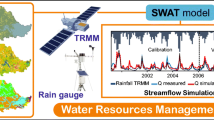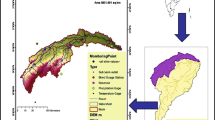Abstract
One subproject within the project IWAS aims at the identification of effective and sustainable measures to improve the water quality of the river basin Western Bug in the Ukraine in preparation of changes of climate, land use and socio-economy. An important part of the system analysis is the quantification of water balance components. Rare and uncertain data impede hydrological modelling in the region. Approaches to reduce the modelling uncertainty are needed. In this work, we focus on the reduction of uncertainty that results from precipitation observations and parameter estimation during the calibration process. The main aim is to set up a well performing model for water balance simulations. The semi-physically based model Soil and Water Assessment Tool (SWAT) was applied. A calibration and uncertainty reduction strategy was set up that consists of time- and spatial-scale dependencies as well as alternative precipitation inputs. The single models that were set up and calibrated with alternative precipitation inputs are treated as an ensemble and were averaged with different methods. Nine parameters were chosen from the completed sensitivity analysis for all calibration approaches. The calibration strategy revealed the benefit of applying a complex bottom-up calibration that starts with sub-basins and ends with the entire basin. Not only performance improved significantly, but also water balance gaps were identified and henceforth reduced. The usage of daily runoff data in the calibration procedure did not enhance simulations in comparison to monthly data. Simulations improved and parameter uncertainty was reduced applying the SWAT model variants, where precipitation was included in calibration and by the ensemble averaging of the different models. Nevertheless, chosen uncertainty measures are not optimal and indicate that parameter uncertainty is still high. This is attributed to the low density of precipitation stations in the region, their low representativity, and scarce data situation in general. Differences between modelled and observed runoff are large in some occasions and can not be balanced completely by the applied methods. Although this approach reached its limit, it was demonstrated that simulations can be improved and modelling uncertainty can be reduced with an appropriate calibration strategy, with extended precipitation information and the application of an ensemble approach.




Similar content being viewed by others
Notes
Available under: https://lpdaac.usgs.gov/products/aster_products_table/astgtm.
References
Abbaspour KC, Johnson C, van Genuchten MT (2004) Estimating uncertain flow and transport parameters using a sequential uncertainty fitting procedure. Vadose Zone J 3:1340–1352
Alexandersson H (1986) A homogeneity test applied to precipitation data. J Climatol 6:661–675
Ångström A (1924) Solar and terrestrial radiation. Q J R Meteorol Soc 50(210):121–126
Arnold JG, Fohrer N (2005) SWAT2000: current capabilities and research opportunities in applied watershed modelling. Hydrol Process 19:563–572
Arnold JG, Srinivasan R, Muttiah R, Williams J (1998) Large area hydrologic modeling and assessment. Part I: model development. J Amer Water Resour Assn 34:73–89
Beven KJ (1993) Prophecy, reality and uncertainty in distributed hydrological modelling. Adv Water Resour 16:41–51
Breuer L, Frede H (2003) PlaPaDa—an online plant parameter data drill for eco-hydrological modelling approaches. http://www.uni-giessen.de/~gh1461/plapada/plapada.html. Accessed 26 June 2013
Carpenter TM, Georgakakos KP (2004) Impacts of parametric and radar rainfall uncertainty on the ensemble streamflow simulations of a distributed hydrologic model. J Hydrol 298(1–4):202–221
Chaubey I, Hann C, Grunwald S, Salisbury J (1999) Uncertainty in the model parameters due to spatial variability of rainfall. J Hydrol 220:48–61
Das T, Bárdossy A, Zehe E, He Y (2008) Comparison of conceptual model performance using different representations of spatial variability. J Hydrol 356:106–118
Dodov B, Foufoula-Georgiou E (2005) Incorporating the spatiotemporal distribution of rainfall and basin geomorphology into nonlinear analyses of streamflow dynamics. Adv Water Resour 28:711–728
Duan Q, Ajami NK, Gao X, Sorooshian S (2007) Multi-model ensemble hydrologic prediction using Bayesian model averaging. Adv Water Resour 30(5):1371–1386
EEA-European Environment Agency (2006) CLC2006 technical guidelines, EEA Report No. 17/2006, Copenhagen. http://www.corine.dfd.dlr.de/papers_en.html. Accessed 26 June 2013
Espinha Marques J, Samper J, Pisani B, Alvares D, Carvalho JM, Chamine HI, Marques JM, Vieira GT, Mora C, Sodre Borges F (2011) Evaluation of water resources in a high-mountain basin in Serra da Estrela, Central Portugal, using a semi-distributed hydrological model. Environ Earth Sci 62(6):1219–1234. doi:10.1007/s12665-010-0610-7
Feldmann H, Früh B, Schädler G, Panitz HJ, Keuler K, Jacob D, Lorenz P (2008) Evaluation of the precipitation for South-western Germany from high resolution simulations with regional climate models. Meteorol Z 17:455–465
Fischer S, Pluntke T, Pavlik D, Bernhofer C (2014) Impact of climate change on various socio-economic sectors in a sub-basin of the Western Bug. Environ Earth Sci (this issue)
Franz KJ, Butcher P, Ajami NK (2010) Addressing snow model uncertainty for hydrologic prediction. Adv Water Resour 33:820–832
Gelman A, Carlin JB, Stern HS, Rubin DB (2003) Bayesian data analysis, 2nd edn. Chapman & Hall/CRC, Boca Raton
Georgakakos KP, Seo DJ, Gupta HV, Schaake JC, Butts MB (2004) Towards the characterization of streamflow simulation uncertainty through multimodel ensembles. J Hydrol 298:222–241
Green CH, Tomer MD, Di Luzio M, Arnold JG (2006) Hydrologic evaluation of the soil and water assessment tool for a large tile drained watershed in Iowa. Trans ASABE 49(2):413–422
Hinterding A (2003) Entwicklung hybrider Interpolationsverfahren für den automatisierten Betrieb am Beispiel meteorologischer Größen. Inst. f. Geoinformatik, Westfälische Wilhelms-Universität Münster (in German)
Hirt U, Hammann T, Meyer BC (2005) Mesoscalic estimation of nitrogen discharge via drainage systems. Limnologica 35:216–219
Hsu KL, Moradkhani H, Sorooshian S (2009) A sequential Bayesian approach for hydrologic model selection and prediction. Water Resour Res 45(12):1–15
Jaeger EB, Anders I, Lüthi D, Rockel B, Schär C, Seneviratne SI (2008) Analysis of ERA40-driven CLM simulations for Europe. Meteorol Z 17:349–367
Kavetski D, Franks SW, Kuczera G (2006) Bayesian analysis of input uncertainty in hydrological modeling: 1. Theory. Water Resour Res 42(3). doi:10.1029/2005WR004368
Kiesel J, Fohrer N, Schmalz B, White MJ (2010) Incorporating landscape depressions and tile drainages of lowland catchments into spatially distributed hydrologic modelling. Hydrol Proc 24:1472–1486
Kleintank AMG et al (2002) Daily data set of 20th-century surface air temperature and precipitation series for the European Climate Assessment. Int J Climatol 22:1441–1453
Körner P, Pluntke T (2014) Inverse determination of groundwater inflow using water balance simulations. Environ Earth Sci (this issue). doi:10.1007/s12665-014-3327-1
Lipinskyy VM, Dyachuk VA, Babichenko VM (2003) Climate of Ukraine. Rayevskyy Publishing, Kyiv, p 343
Liu Y, Gupta V (2007) Uncertainty in hydrologic modeling: toward an integrated data assimilation framework. Water Resour Res 43:W07401. doi:10.1029/2006WR005756
Maraun D, Wetterhall F, Ireson AM, Chandler RE, Kendon EJ, Widmann M, Brienen S, Rust HW, Sauter T, Themeßl M, Venema VKC, Chun KP, Goodess CM, Jones RG, Onof C, Vrac M, Thiele-Eich I (2010) Precipitation downscaling under climate change. Recent developments to bridge the gap between dynamical models and the end user. Rev Geophys 48(3), doi:10.1029/2009RG000314
Masih I, Shreedhar M, Uhlenbrook S, Smakhtin V (2011) Assessing the impact of areal precipitation input on streamflow simulations using the SWAT model. JAWRA 47:179–195
Melnyk I (2006) Problems of water supply of Lviv city: human-geographical analysis. Visnyk Lviv University. Geogr Series 33:248–252
Monteith JL (1965) Climate and the efficiency of crop production in Britain. Philos Trans Res Soc Lond Ser B 281:277–329
Moriasi D, Arnold JG, Van Liew MW, Bingner R, Harmel R, Veith TL (2007) Model evaluation guidelines for systematic quantification of accuracy in watershed simulations. Trans ASABE 50:885–900
Moulin L, Gaume E, Obled C (2009) Uncertainties on mean areal precipitation: assessment and impact on streamflow simulations. Hydrol Earth Syst Sci 13:99–114
Nash JE, Sutcliffe JV (1970) River flow forecasting through conceptual models part I: a discussion of principles. J Hydrol 10(3):282–290
NOAA-National Oceanic and Atmospheric Administration (2010) http://www.ncdc.noaa.gov
Pavlik D, Söhl D, Pluntke T, Mykhnovych A, Bernhofer C (2011) Dynamic downscaling of global climate projections for Eastern Europe with a horizontal resolution of 7 km. Environ Earth Sci 65(5):1475–1482
Pavlik D, Söhl D, Pluntke T, Bernhofer C (2013) Climate change in the Western Bug river basin and the impact on future hydro-climatic conditions. Environ Earth Sci. doi:10.1007/s12665-014-3068-1
Pluntke T, Jatho N, Kurbjuhn C, Dietrich J, Bernhofer C (2010) Use of past precipitation data for regionalisation of hourly rainfall in the low mountain ranges of Saxony, Germany. Nat Hazards Earth Syst Sci 10:353–370
Raftery A, Gneiting T, Balabdaoui F, Polakowski M (2005) Using bayesian model averaging to calibrate forecast ensembles. Mon Weather Rev 133:1155–1175
Rang J (2003) Handbuch und mathematische Grundlagen von METEODATA (Version 2.0.1); Mathematik-Bericht 2003/2. Technische Universität Clausthal, Institut für Mathematik (in German)
Refsgaard JC, van der Sluijs JP, Brown J, van der Keur P (2006) A framework for dealing with uncertainty due to model structure error. Adv Water Resour 29:1586–1597
Rockel B, Will A, Hense A (2008) The regional climate model COSMO-CLM (CCLM). Meteorol Z 17:347–348
Ruelland D, Ardoin-Bardin S, Billen G, Servat E (2008) Sensitivity of a lumped and semi-distributed hydrological model to several methods of rainfall interpolation on a large basin in West Africa. J Hydrol 361:96–117
Rummukainen M (2010) State-of-the-art with regional climate models. Wiley Interdiscip Rev Clim Change 1:82–96. doi:10.1002/wcc.8
Schanze J, Truemper J, Burmeister C, Pavlik D, Kruhlov I (2012) A methodology for dealing with regional change in integrated water resources management. Environ Earth Sci 65(5):1405–1414
Segond ML, Wheater HS, Onof C (2007) The significance of spatial rainfall representation for flood runoff estimation: a numerical evaluation based on the Lee catchment, UK. J Hydrol 347:116–131
Sharma A, Chowdhury S (2011) Coping with model structural uncertainty in medium-term hydro-climatic forecasting. Hydrol Res 42:113–127
Strauch M, Bernhofer C, Koide S, Volk M, Lorz C, Makeschin F (2012) Using precipitation data ensemble for uncertainty analysis in SWAT streamflow simulation. J Hydrol 414–415:413–424
Sudheer KP, Chaubey I, Garg V, Migliaccio KW (2007) Impact of time-scale of the calibration objective function on the performance of watershed models. Hydrol Process 21:3409–3419
TACIS (2001) Transboundary water quality monitoring and assessment: bug and Latorica/Uzh, Kyiv. Summary report and recommendations of the project. EU
Tavares Wahren F, Tarasiuk M, Mykhnovych A, Kit M, Feger KH, Schwärzel K (2012) Estimation of spatially distributed soil information. Dealing with data shortages in the Western Bug Basin, Ukraine. Environ Earth Sci 65:1501–1510
Uppala SM et al (2005) The ERA-40 re-analysis. Q J R Meteorol Soc 131:2961–3012
van Griensven A, Meixner T, Grunwald S, Bishop T, Diluzio M, Srinivasan R (2006) A global sensitivity analysis tool for the parameters of multi-variable catchment models. J Hydrol 324:10–23
Villarini G, Mandapaka P, Krajewski W, Moore R (2008) Rainfall and sampling uncertainties: a rain gauge perspective. J Geophys Res 113:D11102. doi:10.1029/2007JD009214
Vrugt JA, Robinson BA (2007) Treatment of uncertainty using ensemble methods: comparison of sequential data assimilation and Bayesian model averaging. Water Resour Res 43:W01411. doi:10.1029/2005WR004838
WMO (2003) Guidelines on climate observation networks and systems. World Meteorological Organization, Geneva, TD No. 1185, p 57
Yang J, Reichert P, Abbaspour KC, Xia J, Yang H (2008) Comparing uncertainty analysis techniques for a SWAT application to the Chaohe Basin in China. J Hydrol 358:1–23
Zhang X, Srinivasan R, Bosch D (2009) Calibration and uncertainty analysis of the SWAT model using genetic algorithms and Bayesian model averaging. J Hydrol 374:307–317
Acknowledgments
This work was supported by funding from the German Federal Ministry for Education and Research (BMBF) in the framework of the project “IWAS-International Water Research Alliance Saxony” (Grant 02WM1028). The authors would like to thank the State Environment Agency Rheinland-Pfalz, Germany, for providing the software package InterMet for this work. We acknowledge the data providers in the ECA&D project. We are very grateful to Stefanie Fischer, who in her Diploma thesis contributed substantially in the statistical analysis of some meteorological variables. Discussion with Michael Strauch helped to identify and solve problems, thanks for that. The valuable comments of the reviewers are greatly acknowledged. They significantly improved the quality of the manuscript.
Author information
Authors and Affiliations
Corresponding author
Rights and permissions
About this article
Cite this article
Pluntke, T., Pavlik, D. & Bernhofer, C. Reducing uncertainty in hydrological modelling in a data sparse region. Environ Earth Sci 72, 4801–4816 (2014). https://doi.org/10.1007/s12665-014-3252-3
Received:
Accepted:
Published:
Issue Date:
DOI: https://doi.org/10.1007/s12665-014-3252-3




